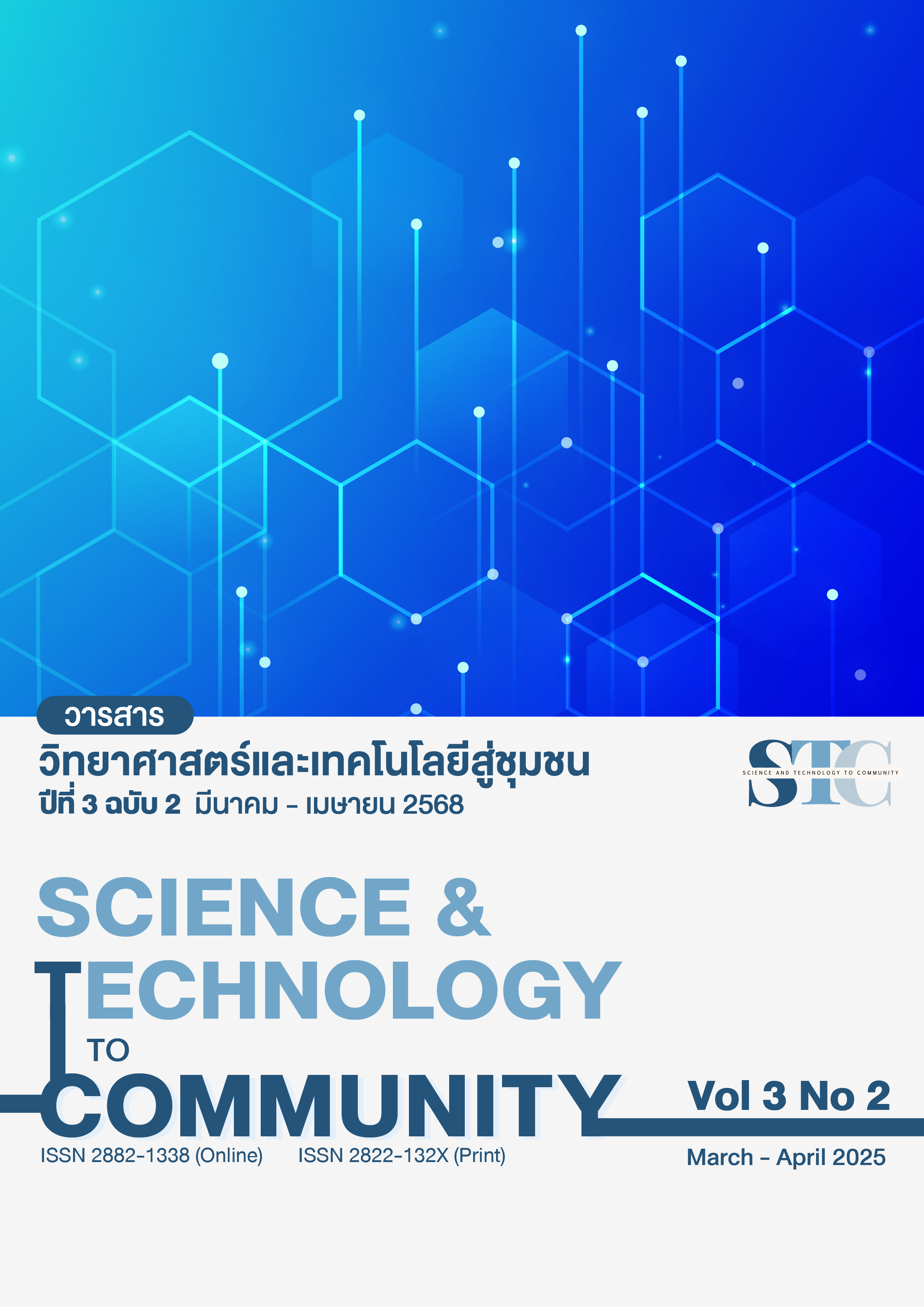การพัฒนาระบบการดูแลแบบมีส่วนร่วม กรณีศึกษาในผู้ดูแลผู้ป่วยจิตเวชจากการใช้ สารเสพติด โรงพยาบาลหว้านใหญ่ อำเภอหว้านใหญ่ จังหวัดมุกดาหาร
DOI:
https://doi.org/10.57260/stc.2025.1005คำสำคัญ:
ผู้ป่วยจิตเวช , สารเสพติด , การมีส่วนร่วมของชุมชน , การดูแลแบบ New normal , การพัฒนาระบบการดูแลบทคัดย่อ
การวิจัยนี้มีวัตถุประสงค์เพื่อพัฒนาระบบการดูแลผู้ป่วยจิตเวชจากการใช้สารเสพติดแบบมีส่วนร่วม โรงพยาบาลหว้านใหญ่ อำเภอหว้านใหญ่ จังหวัดมุกดาหาร การวิจัยใช้วิธีการแบบ R&D (Research and Development) โดยแบ่งการดำเนินการออกเป็น 3 ระยะ ได้แก่ 1) การศึกษาความรู้ ทัศนคติ และการมีส่วนร่วมของผู้ดูแล 2) การพัฒนาระบบการดูแลโดยใช้กระบวนการ A-I-C (Appreciation, Influence, Control) และ 3) การประเมินผลระบบที่พัฒนาขึ้น ผลการศึกษาพบว่าผู้ดูแลส่วนใหญ่มีระดับความรู้เกี่ยวกับโรคจิตเวชจากสารเสพติดในระดับสูง (58.40%) ระบบที่พัฒนาขึ้นสามารถลดภาระการทำงานของเจ้าหน้าที่และเพิ่มการมีส่วนร่วมของชุมชน นอกจากนี้ การใช้เทคโนโลยี เช่น VDO Call และแอปพลิเคชันช่วยเพิ่มความสะดวกในการติดตามและลดการเดินทางของผู้ป่วย การประเมินผลแสดงให้เห็นว่าระบบสามารถลดอาการกำเริบของผู้ป่วยได้อย่างมีนัยสำคัญ สร้างความยั่งยืนและความพึงพอใจในชุมชน
Downloads
เอกสารอ้างอิง
กรมสุขภาพจิต กระทรวงสาธารณสุข. (2565). คู่มือการดูแลผู้ป่วยโรคจิตเภท สําหรับโรงพยาบาลในเขตสุขภาพ (ฉบับพยาบาล/นักวิชาการสาธารณสุข). กรุงเทพฯ: บริษัท วิคทอเรียอิมเมจ จํากัด.
กองบริหารระบบบริการสุขภาพจิต กระทรวงสาธารณสุข. (2563). คู่มือการดูแลผู้ป่วยจิตเวชที่มีความเสี่ยงสูงต่อการก่อความรุนแรงสําหรับสถาบัน/โรงพยาบาล สังกัดกรมสุขภาพจิต. กรุงเทพฯ: บริษัท พรอสเพอรัสพลัส จํากัด.
กองบริหารระบบบริการสุขภาพจิต กรมสุขภาพจิต กระทรวงสาธารณสุข. (2563). แผนพัฒนาสุขภาพจิตแห่งชาติ ฉบับที่ 1 (พ.ศ. 2561-2580). กรุงเทพฯ: กระทรวงสาธารณสุข.
กองยุทธศาสตร์และแผนงาน กระทรวงสาธารณสุข. (2564). รายงานสถานการณ์สุขภาพจิตในประเทศไทย. กรุงเทพฯ: กระทรวงสาธารณสุข.
นวรัตน์ สุวรรณผ่อง และ ฉวีวรรณ บุญสุญา. (2542). การประเมินผลและเขียนแผนงาน/โครงการด้านสาธารณสุข. พิมพ์ครั้งที่ 1. กรุงเทพฯ: พรทิพย์การพิมพ์. เนาวรัตน์เจริญค้า.
บุญชม ศรีสะอาด. (2545). วิธีการวิจัยเบื้องต้น. พิมพ์ครั้งที่ 7. กรุงเทพฯ: สุวีริยาสาส์น.
บำรุง วงษ์นิ่ม, แสงเดือน ดีผิว และ สุรพล สุพวง. (2566). การพัฒนาระบบการดูแลผู้ป่วยจิตเวชสารเสพติดโดยการมีส่วนร่วมและไร้รอยต่อ ตัวแบบลพบุรี: กรณีศึกษาอำเภอโคกสำโรง. วารสารวิชาการสาธารณสุขชุมชน, 10(1), 1-12. สืบค้นจาก https://he02.tci-thaijo.org/index.php/ajcph/article/view/265916
พรทิพย์ วชิรดิลก, ธีระ ศิริสมุด และ อนุรัตน์ สมตน. (2561). ผู้ป่วยฉุกเฉินวิกฤตสุขภาพจิตที่เข้าถึงระบบบริการการแพทย์ฉุกเฉินในประเทศไทย. วารสารการพยาบาลจิตเวชและสุขภาพจิต, 32(2), 69-83. สืบค้นจาก https://he02.tci-thaijo.org/index.php/JPNMH/article/view/138685
พวงรัตน์ ทวีรัตน์. (2543). วิธีการวิจัยทางพฤติกรรมศาสตร์และสังคมศาสตร์. พิมพ์ครั้งที่ 7. กรุงเทพฯ: สำนักทดสอบทางการศึกษาและจิตวิทยา มหาวิทยาลัยศรีนครินทรวิโรฒ.
รัศมี ชุดพิมาย. (2565). การพัฒนารูปแบบการดูแลผู้ป่วยจิตเวชเรื้อรังกลุ่มเสี่ยงในชุมชนด้วยกระบวนการมีส่วนร่วมของภาคีเครือข่าย อําเภอลําปลายมาศ จังหวัดบุรีรัมย์. วารสารศูนย์อนามัยที่ 9, 16(3), 850-867. สืบค้นจาก https://he02.tci-thaijo.org/index.php/RHPC9Journal/article/view/258728
ศูนย์อำนวยการป้องกันและปราบปรามยาเสพติด. (2565). รายงานสถานการณ์สารเสพติดในประเทศไทย. กรุงเทพฯ: กระทรวงยุติธรรม.
Denzin, N. K. (1978). Triangulation: A Case for Methodological Evaluation and Combination. Sociological Methods.
ดาวน์โหลด
เผยแพร่แล้ว
รูปแบบการอ้างอิง
ฉบับ
ประเภทบทความ
สัญญาอนุญาต
ลิขสิทธิ์ (c) 2025 วารสารวิทยาศาสตร์และเทคโนโลยีสู่ชุมชน

อนุญาตภายใต้เงื่อนไข Creative Commons Attribution-NonCommercial-NoDerivatives 4.0 International License.
1. บทความ ข้อมูล เนื้อหา รูปภาพฯลฯ ที่ได้รับการตีพิมพ์ใน “วารสารวิทยาศาสตร์และเทคโนโลยีสู่ชุมชน” ถือเป็นลิขสิทธิ์ของวารสารวิทยาศาสตร์และเทคโนโลยีสู่ชุมชน มหาวิทยาลัยราชภัฏเชียงใหม่ หากบุคคลหรือหน่วยงานใดต้องการนำทั้งหมดหรือส่วนหนึ่งส่วนใดไปเผยแพร่ต่อหรือกระทำการใดๆ จะต้องได้รับอนุญาตเป็นลายลักษณ์อักษรจาก วารสารวิทยาศาสตร์และเทคโนโลยีสู่ชุมชน มหาวิทยาลัยราชภัฏเชียงใหม่
2. เนื้อหาบทความที่ปรากฏในวารสารเป็นความรับผิดชอบของผู้เขียนบทความโดยตรง ซึ่งกองบรรณาธิการวารสารไม่จำเป็นต้องเห็นด้วยหรือร่วมรับผิดชอบใดๆ














